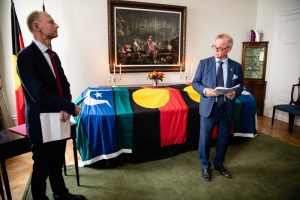Läkande, försoning och upprättelse
English version below
I går kväll deltog jag som KI:s officiella representant i samband med det ceremoniella återlämnandet av kvarlevor från sju individer till Australien. Kvarlevorna har ingått i Karolinska Institutets anatomiska samling och fördes till Sverige under andra halvan av 1800-talet. Nu ska de återbördas till de ursprung varifrån de en gång togs – oftast utan varken hänsyn eller respekt för de avlidna eller deras anhöriga.
Ceremonin präglades av allvar, vördnad och respekt. Det här är viktigt framförallt för de folk som nu får tillbaka kvarlevorna av sina förfäder, men också för oss på KI. Det är ett erkännande av de drabbades självklara rättigheter och behov av upprättelse.
Bidra till läkande och försoning
I samband med återlämnandet höll jag ett tal där jag bland annat betonade att ingenting i historien kan göras ogjort, men att vi arbetar för att så långt det går rätta till situationen – och att vi har en ärlig och uppriktig vilja att i möjligaste mån kunna bidra till läkande, försoning och upprättelse.
Vi har också en skyldighet att ständigt reflektera över hur vi behandlar våra medmänniskor i forskningens namn – även i dag.
Fortsatt arbete
KI fortsätter arbetet med att inventera och dokumentera mänskliga kvarlevor som finns i vår anatomiska samling. Detta projekt startade 2015 och ambitionen är att de kvarlevor från urfolk som kan identifieras sedan ska återlämnas till de aktuella ursprungen. Detta inkluderar också de kvarlevor som kan finnas från den samiska befolkningen.
Jag skulle vilja rikta ett stort tack till alla de som varit behjälpliga i det här arbetet. Särskilt tack till Australiens ambassadör Jonathan Kenna samt Olof Ljungström och Eva Åhrén på KI:s enhet för medicinens historia och kulturarv samt till de representanter för berörda folkgrupper som gjort denna återlämning möjlig och som nu får en möjlighet att återbörda kvarlevorna från sina förfäder till sin hemmiljö.
Läs gärna mer på KI:s webbplats. Sveriges Radios Ekoredaktion sände ett inslag om ceremonin i går eftermiddag. Även flera andra redaktioner uppmärksammade återlämnandet.
Healing, reconciliation and redress
Last night, I represented KI at the handover ceremony of ancestral remains from seven individuals to Australia. The remains have been part of Karolinska Institutet’s anatomical collection and were brought to Sweden during the second half of the 19th century. Now they will be returned to the communities from which they once were taken, in many cases without respect for the deceased or their relatives.
The ceremony was characterized by solemnity, homage and respect. This was an important event, especially for those who now receive the remains of their ancestors, but also for us at KI. It is a recognition of the indigenous people’s clear rights and needs for redress.
Contribute to healing and reconciliation
In my speech I emphasized that we cannot undo wrongs of the past, but that we have an honest and sincere willingness to contribute as far as possible to healing, reconciliation and redress.
We also have an obligation to constantly reflect on how we treat our fellow human beings in the name of research – both then and now.
The work continues
KI continues the work of inventorying and documenting human remains in our anatomical collection. This project started in 2015, and the ambition is that remains of indigenous peoples that can be identified will be returned to their communities of origin. This also includes the remains that may exist from the Sami people.
I would like to express my gratitude to all those who have been helpful in this work. Specialthanks to the Australian ambassador, Mr Jonathan Kenna, and Olof Ljungström and Eva Åhrén at the KI Unit for the History and Heritage of Medicine. I would also like to thank the representatives of the indigenous communities who made this repatriation possible.

During the ceremony yesterday.
Ambassador Jonathan Kenna to the left.
Photo: Erik Cronberg


0 comments